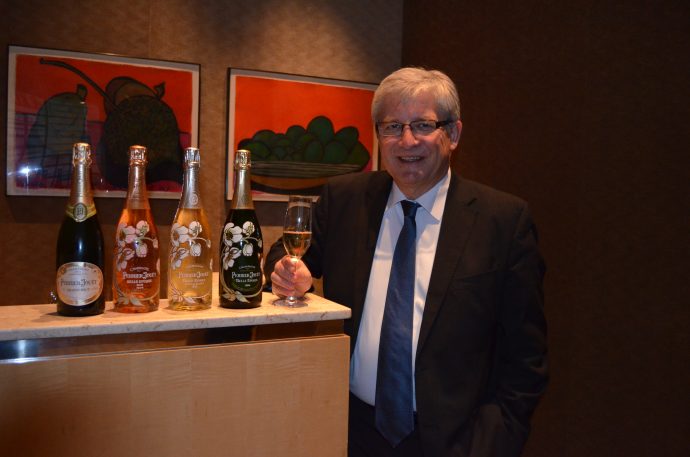In my world, little else compares to the pop of a bottle of sparkling wine being opened. In one glorious pop, or more properly, a gently eased-out “pfffttt,” your day changes. This sound alone makes people giddy with anticipation. It tells everyone present your work day is done and it’s time to chillax. It’s time to enjoy the playful bubbles and connect with someone – or everyone.
Champagne has done an amazing PR job over the years linking itself to celebration. What wedding, anniversary, birthday or graduation would be complete without something sparkling to kick things off? Well-made sparkling wines are a wonderful house-warming gift, or dinner gift or any-other-time gift. Even before your first taste, I don’t know if it’s the bubbles that look like micro dancing balloons in the glass, but something gives you the feeling of being elevated, of being raised above your worldly troubles, of being transported to a place of relaxation and communion and connection. It’s true: Bubbly implies “party,” in a classy and sophisticated way.
With the dot-com economy howling in the ’90s, dinner guests would often appear at my home with a bottle of Champagne. We would “pop” and toast and clink glasses and settle into an afternoon and/or an evening of spirited conversation and fun.
Then the economy tanked and teetered on the precipice of worldwide depression. And what happened next? Guests no longer brought Champagne to my house. They brought Prosecco. Talk about depression. I savor traditional and well-made bubblies. I love exploring the crisp citrus component or the yeasty “freshly-made-croissant” component. I won’t open a bottle of Prosecco unless there are at least six people, because one pour is enough for me. The bubbles tend to be seafoam froth and don’t linger. But well-made bubbly? Now that’s something to investigate.
The difference between the two is the production method. Most Proseccos and other industrial sparkling wines employ the Charmat method. They ferment the grape juice turning it into wine. Then it’s put in bulk tanks with more sugar and yeasts to create a second fermentation, which is then bottled.
In Champagne and other sparkling wine areas, they use the Méthode Champenoise or Méthode Traditionnelle. In this technique, the juice is fermented in tanks or barrels. Then this still wine is bottled, some sugar and yeasts are added and a secondary fermentation occurs in the bottle.
But this method creates dead yeast cells and sediment in the bottle that need to be removed without diluting the bubbles. The bottles are placed in riddling racks and turned a quarter of a turn and tipped slightly more vertically and upside-down each day. A good riddler can turn 50,000 bottles in a day. When the bottle is almost vertical, the sediment all collects in the neck.
Disgorgement is the process of removing the sediment by dipping the neck of the bottle in a very cold liquid that immediately freezes the sediment into an ice plug. The cap is taken off the bottle, and the ice plug is forcibly ejected by pressure. The bottle is then topped off with more wine and re-corked and caged.
There are so many good producers of traditional method sparkling wines. Virtually all the wine regions of the world are making sparkling wines. Some of the regions are dedicated almost exclusively to sparkling wines, such as Franciacorta in north-central Italy. Others make sparklers as an adjunct to their portfolio. Look for Crémant sparklers. These are delicious bubblies made in Burgundy, Alsace or the Loire Valley among other places. They are made in the traditional method and are considerably less expensive than Champagne.
California, New Mexico, Virginia and Massachusetts are but a few of the many states that produce lovely sparkling wines. I have just opened an inexpensive Gloria Ferrer Blanc de Noirs from Carneros in Napa, Calif. for inspiration for this story. It’s dry with a frothy citrusy component and a background flavor of toast. Retailing at under $20, it is refreshing and worthy.
Sparkling wines can be bone-dry, quite sweet or anything in between. They are usually white but can also be Rosé or even red. Smaller wine stores are likely only to have a few options in different price points. I like to buy sparklers at mega-stores like Total Wine (totalwine.com) in Norwalk, just off the Merritt Parkway on old Route 7 (Main Avenue). It offers hundreds of sparkling wines from all over the world and from all over the pricing spectrum. There are also inexpensive wine classes sometimes featuring sparklers.
As the holidays approach and the invitations appear in your mailbox and on your computer and you’re wanting to bring something that goes with everything and something that is enjoyed by most everyone, find some well-made bubbly. The traditional method of production is obviously more expensive than the bulk-made Charmat method, so expect to pay a few more bucks for it. Online wine sites like wtso.com often offer up heavily discounted bubblies.
Oh, and glassware is important. Narrow flutes concentrate the bubbles but the flavors remain somewhat constricted. Bowl-shaped glasses will dilute both the bubbles and flavors. Look for a typical white wine glass, vertically walled. Bubbles and expression: Now we’re talking!
Write me at doug@dougpaulding.com.


